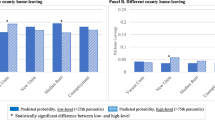Abstract.
This study follows teens through young adulthood as they transition to independent living. We focus on a little studied issue: why some youths live in groups rather than alone or with parents. This choice is important because the size of the group has a substantial impact on the demand for dwelling units; the more youths per dwelling the lower is aggregate demand and the greater is population density. Our study also adds to the knowledge of which factors influence youths' choice of destination as they leave the parental home. The empirical testing uses a discrete hazard model within a multinomial logit framework to allow for more than one possible state transition. We find that economic variables have little impact on the decision of whether to exit to a large versus a small group, while socio-demographic variables matter. We also test a new push-pull hypothesis and find that the pull of economic variables on the probability of exiting the parental home increases as youths reach their mid to late twenties.
Similar content being viewed by others
Author information
Authors and Affiliations
Additional information
Received: 15 July 1999/Accepted: 15 May 2000
Rights and permissions
About this article
Cite this article
Garasky, S., Haurin, R. & Haurin, D. Group living decisions as youths transition to adulthood. J Popul Econ 14, 329–349 (2001). https://doi.org/10.1007/s001480000053
Issue Date:
DOI: https://doi.org/10.1007/s001480000053




